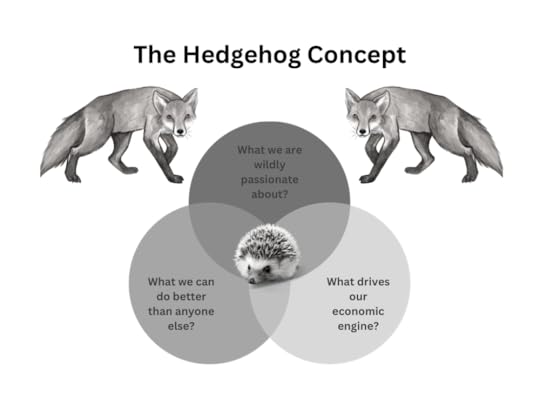Omar L. Harris's Blog
October 26, 2025
Leadership Unmasked: Why Good Intentions Aren’t Good Leadership
October 13, 2025
A World Focused on the Wrong Criteria, and Tools
September 2, 2025
From Good to Great to W.H.O.M.: The Missing Link
August 18, 2025
Resumé Roulette: Why the System Fails and What to Do Instead
December 18, 2024
The Four C’s of Influencing: How Leaders Build Agency With and Without Authority

Leadership in today’s world is less about titles and more about influence. Whether you sit at the top of the hierarchy or lead from the middle, the most effective leaders are those who inspire action, empower their teams, and drive change—often without traditional authority. At the heart of this ability lies mastery of the Four C’s of Influencing: Cultivating Agency, Connecting, Communicating, and Convincing. Together, these principles form a roadmap for creating impact that transcends power structures, unlocking potential in both individuals and organizations.
Imagine being in a boat without a paddle, carried along by the current. That’s what leadership feels like without agency—reactive, uncertain, and directionless. Cultivating agency is about grabbing the paddle and steering with purpose. It starts with leveraging your attitude and actions to foster focus, accountability, and influence within yourself and others.
Leaders who cultivate agency embrace a proactive mindset. They don’t wait for opportunities; they create them. They practice accountability by owning their decisions and modeling this behavior for their teams. Most importantly, they empower others to do the same. When leaders cultivate agency, their teams stop looking for permission to act—they take initiative, solve problems, and own outcomes.
A leader’s mantra here is simple: “I trust you to make it happen.” By fostering an environment where agency thrives, leaders multiply their influence, allowing others to lead from within.
Leadership without connection is like shouting into a void. The second C, Connecting, is about building trust, creating proximity, and consistently adding value to relationships. Influence begins with credibility, and credibility comes from showing people you genuinely care about their success.
Connection starts with empathy—understanding what motivates others and aligning with their goals. It deepens through consistent actions that demonstrate reliability and integrity. Leaders who connect well don’t just deliver results; they build relationships. They ask questions, listen actively, and ensure others feel seen, heard, and valued.
Proximity is also key. Leaders who are approachable and present cultivate a sense of shared purpose. They show up where it matters, whether it’s a team brainstorming session, a one-on-one coaching moment, or an informal chat over coffee. These seemingly small interactions build the relational equity that makes influence possible.
Connection tip: Add value before asking for buy-in. People are far more likely to follow when they see you’re invested in their growth and success.
Every leader needs a story—a compelling narrative that inspires action. The third C, Communicating, is about crafting and delivering messages that resonate deeply. Whether rallying a team around a vision or persuading a stakeholder to take a risk, effective communication creates clarity, sparks enthusiasm, and drives action.
To communicate with impact, leaders must first master the art of storytelling. Facts inform, but stories inspire.
A well-crafted narrative ties personal meaning to broader organizational goals, making the abstract feel tangible. For example, instead of saying, “We need to increase sales by 20%,” a leader might say, “Imagine the lives we could change if we reached 20% more customers. What stories could we create together?”
Equally important is how leaders frame challenges. Great communicators reframe obstacles as opportunities. Instead of presenting problems, they inspire action by focusing on solutions and possibilities.
Pro tip: Don’t just share the what; share the why. A narrative with purpose is one that people want to be part of.
Even the most compelling narrative falls flat without the ability to Convince others to adopt it. The fourth C is about using the right approaches at the right time to inspire action and commitment.
Leaders convince by tailoring their approach to the situation and the individuals involved. Techniques like cooperative assertiveness—boldly advocating for ideas while inviting collaboration—create alignment without alienation. Inquiry-based conversations encourage others to explore solutions themselves, fostering ownership and buy-in.
When faced with resistance, leaders employ paradoxical solutions to reframe disagreements. Instead of choosing sides, they find a way to integrate competing perspectives, avoiding zero-sum outcomes. This shift from "either-or" to "both-and" thinking leads to creative win-win solutions that everyone can rally behind.
Most importantly, leaders convince by making others feel part of the cause. Influence isn’t about imposing ideas; it’s about inspiring shared ownership. When people see their fingerprints on a decision, they’re far more likely to follow through with commitment.
Let’s bring this to life with a real-world example. When Emma Santos became Head of Product Development at NovaTech, she faced a team that lacked agency and alignment. Applying the Four C’s, Emma turned the tide.
Cultivating Agency: Emma empowered her team by introducing “empowerment zones” where they could make decisions autonomously. She practiced accountability herself, openly owning mistakes and modeling resilience.
Connecting: Emma built trust through consistent one-on-ones, genuinely listening to her team’s aspirations and challenges. By adding value to their growth, she gained their trust and loyalty.
Communicating: Emma crafted a compelling vision for the team, tying their daily efforts to the company’s mission of innovation and impact. Her stories transformed abstract goals into a shared purpose.
Convincing: Emma used inquiry and cooperative assertiveness to inspire collaboration. When team conflicts arose, she reframed them as opportunities for win-win solutions. Her team not only adopted her vision—they made it their own.
The result? Emma’s team went from reactive to proactive, delivering record-breaking results and becoming a model for other departments.
The Four C’s of Influencing—Cultivating Agency, Connecting, Communicating, and Convincing—are the keys to leading with and without authority. They transform leaders from mere decision-makers into true influencers who inspire action, build trust, and drive change.
Leadership isn’t about control; it’s about empowerment. When you master the Four C’s, you create a culture where people take ownership, align with purpose, and collaborate toward shared success. And in that culture, your influence becomes limitless.
Are you ready to lead with the Four C’s? Start today. Cultivate agency, connect with others, craft compelling narratives, and convince with impact. The ripple effects will be undeniable—and so will your legacy.

December 9, 2024
Unlocking the Power of a North Star: How a Unifying Purpose Inspires Extraordinary Achievements

In the biting cold, halfway up a sheer cliff face on Mount Everest, Nirmal "Nims" Purja paused to catch his breath. Most climbers would never attempt such a brutal pace; they’d likely turn back, discouraged by the sheer magnitude of scaling just one of the world’s 14 highest peaks. But Nims wasn’t climbing just for himself. His North Star was a profound mission: to elevate the Nepalese Sherpa community, the unsung heroes of the Himalayas who had guided climbers from around the world to the top of the world’s most dangerous mountains for decades, yet received little recognition.
With each step, Nims was driven by an unwavering belief—that the Sherpas, the indigenous people who knew these mountains better than anyone, deserved respect, acknowledgment, and a place in mountaineering history. His mission was about rewriting the narrative, proving to the world what these resilient climbers could achieve. By setting out to conquer all 14 of the world’s 8,000-meter peaks in record time, Nims sought to inspire not only a new generation of climbers but to uplift his entire community and demonstrate the power of purpose-driven ambition.
This story of one man and his team overcoming unimaginable odds holds a universal truth: when people come together under a powerful purpose, they become unstoppable. This is the essence of a North Star. It’s more than just a goal; it’s a unifying force that brings people together, drives them to reach beyond what they thought possible, and ignites a shared commitment to something bigger than themselves.
In 2019, Nims achieved what most thought impossible: he scaled the world’s 14 highest peaks in just 189 days. But this wasn’t just about breaking records; it was about shattering human limits, challenging beliefs, and uplifting his community. Nims’ accomplishment was not a solo journey. Each climb was a team effort, with people from different backgrounds and skill sets coming together to support one man’s unshakeable vision.
With his North Star as a guide, Nims transformed his mission into a movement, inspiring countless others to respect and celebrate the Sherpa community.

The term “North Star” originates from the ancient practice of navigation, where travelers and sailors relied on the North Star (Polaris) to find their way. Polaris holds a fixed position in the sky, providing a consistent point of reference that guides people through unfamiliar territory. In business, a North Star provides that same unwavering guidance. It offers a point of clarity and purpose, a guiding light that helps teams and organizations stay true to their most important goals, even as they navigate changing environments.
While the idea of a North Star as a guiding principle has ancient roots, its popularity in business circles can be attributed to Silicon Valley and the start-up world. Leaders in tech recognized the need for a unifying purpose and began coining the term “North Star Metric.” Sean Ellis, a pioneer in growth hacking, championed this concept, identifying a North Star Metric as a single, defining measure that represented the core of a company’s mission. This metric became a focal point for growth, aligning every effort toward the same overarching goal.
Since then, the concept has evolved, transcending metrics to represent a broader, enduring mission or vision that drives and inspires. Just like Polaris, a North Star in business remains steady, keeping teams aligned and focused on the long-term impact of their work. This guiding principle reminds teams of their purpose, helping them find their way forward regardless of obstacles.
A North Star isn’t just a mission statement; it’s a strategic force that guides every decision and action. When people understand why they’re pushing forward and see the impact of their efforts, engagement and resilience skyrocket. Leaders who set a clear North Star align their teams around a purpose that resonates deeply. They’re not just working to achieve targets; they’re building a legacy. When individuals and teams embrace this North Star mentality, they transcend self-interest and work together to achieve something monumental.

In his classic Good to Great, Jim Collins introduces the concept of Level 5 Leadership—an extraordinary blend of fierce ambition and humility. Level 5 Leaders, like Nims Purja, are driven by a purpose that’s far bigger than personal gain. This is what Collins calls Level 5 Ambition—an unstoppable drive toward a North Star that unites and inspires everyone around it.
Consider Darwin Smith, former CEO of Kimberly-Clark, who transformed a struggling company into a market leader. Smith’s North Star was bold: to make Kimberly-Clark the best paper company in the world. Against all odds, he stayed true to his vision, inspiring his team to redefine their industry. Kimberly-Clark became a powerhouse not through individual achievements but by a shared purpose. This is the magic of a North Star—it binds people together and turns ordinary work into something transformative.

Another key insight from Collins is the Hedgehog Concept, a strategic focus that helps teams and organizations zero in on what truly matters. The Hedgehog Concept teaches us that greatness doesn’t come from trying to be everything to everyone. Instead, it comes from aligning our passions, strengths, and resources with a single, focused mission.
When teams rally around a North Star that aligns with this Hedgehog Concept, they become a unified force. Distractions fall away, and every decision, action, and resource is devoted to the mission. Imagine a team laser-focused on a singular goal, working in harmony toward something greater than themselves. They’re not just climbing a mountain—they’re reshaping an entire narrative.
 How to Find Your North Star: A Leader’s Guide
How to Find Your North Star: A Leader’s Guide
If you’re ready to ignite this level of commitment and ambition within your team, start with these steps:
Identify Your Purpose: Ask yourself why your work matters—not just in business terms but in terms of legacy and impact. Purpose-driven missions resonate deeply, not only with employees but also with customers and partners.
Craft a Compelling Vision: A North Star isn’t just a target; it’s a vision of the future that everyone can see, feel, and believe in. This vision should be bold enough to challenge and inspire.
Align on Core Values: Once your North Star is defined, ensure your values align with and support it. Core values guide behavior, creating a culture that brings the North Star to life.
Set Audacious Goals: Don’t shy away from big ambitions. Bold goals ignite passion and a sense of purpose, and a North Star that challenges people pushes them to rise above the ordinary.
Here’s what happens when leaders and teams embrace a North Star mentality:
Elevates Engagement: When people know they are part of something meaningful, they’re more motivated and loyal. They’re not just employees—they’re advocates for the mission.
Inspires Resilience: A North Star creates a culture where people face challenges with courage, turning setbacks into opportunities.
Ignites Innovation and Productivity: Purpose-focused teams innovate and work smarter, knowing their efforts directly impact the mission. They’re not just busy; they’re achieving.
Strengthens Brand Loyalty: Purpose-driven brands attract customers and partners who believe in their mission, building a community of supporters around their North Star.
A North Star isn’t just a destination—it’s a guiding light that illuminates the path forward. Stories like Nims Purja’s, Level 5 Leaders, and the Hedgehog Concept reveal the power of purpose-driven focus. When people rally around a shared vision, they tap into potential they never knew existed.
As a leader, your responsibility is to find this North Star and help your team see it too. This isn’t just about setting goals—it’s about igniting a movement that can change the lives of everyone involved. When people are united by a powerful purpose, greatness isn’t just a possibility; it’s an inevitability. So find your North Star and let it guide you toward extraordinary achievement.
In a world where true greatness can feel out of reach, a North Star reminds us that the journey is just as important as the destination. With a purpose-driven vision, aligned values, and bold ambition, you can inspire your team to reach for the impossible—and achieve it. Find your North Star, embrace it, and watch as it transforms the lives of everyone who joins you on the journey.
Omar L. Harris is the managing partner at Intent Consulting , a firm dedicated to improving employee experience and organizational performance and author of Leader Board: The DNA of High-Performance Teams; The Servant Leader's Manifesto; Be a J.E.D.I. Leader, Not a Boss: Leadership in the Era of Corporate Social Justice, Equity, Diversity, and Inclusion; Leading Change: The 4 Keys; Hire the Right W.H.O.M.: Sourcing the Right Team DNA Every Time; and The J.E.D.I. Leader's Playbook: The Insider's Guide to Eradicating Injustices, Eliminating Inequities, Expanding Diversity, and Enhancing Inclusion available for purchase in ebook, print, and audio on Amazon.com . Please follow him Instagram , Twitter , and/or his website for more information and engagement.
December 1, 2024
Fixing Feedback: Trust, J.E.D.I. Principles, and the Power of Genuine Connection

Feedback is the pulse of progress. We hear it all the time—feedback fuels growth, drives results, and builds culture. Yet here’s the hard truth: most feedback practices fall flat. We’ve cycled through a variety of methods—the “sandwich” approach, 360-degree reviews, coaching models—and despite the buzz, real change remains elusive. Why? Because feedback isn’t just a skill or a structure; it’s an experience, an exchange, a relationship. And to transform it, we have to dig deeper into the principles that make it truly meaningful.
In my journey leading teams worldwide, I’ve seen firsthand that feedback that sticks is built on trust, respect, and understanding. It’s tailored to individual needs, timed to make an impact, and rooted in a commitment to justice, equity, diversity, and inclusion—the J.E.D.I. principles. These aren’t just buzzwords; they’re the missing ingredients in most feedback cultures.
Let’s explore how leaders can create feedback that resonates, builds loyalty, and fuels excellence.
Without trust, feedback is just noise. Imagine getting told where you need to improve by someone you don’t trust. It feels like criticism, even if it’s constructive. But with trust? Feedback becomes a powerful tool for growth. Trust makes people receptive rather than defensive, and it comes from a place of mutual respect and shared purpose.
Building trust requires leaders to be genuine, open, and consistently honest. It’s about showing up as a real person, not a title. Leaders who model this, who are vulnerable about their own challenges, create an environment where feedback flows naturally. Your people aren’t just hearing words; they’re feeling your support. This shift transforms feedback into something employees want to embrace rather than avoid.
Feedback lands differently for everyone, and that’s because we all approach conflict in unique ways. Some face it head-on, others avoid it, and some navigate it with caution. Recognizing these differences lets leaders meet team members where they are and deliver feedback that sticks.
Take Lynnette, a leader who learned this lesson firsthand. Last year, she gave blunt feedback to Lisa, a talented but reserved team member, hoping to spark growth. Instead, it left Lisa feeling unsupported and deflated. Afterward, Lynnette took a step back and learned about conflict styles, realizing Lisa responded better to a softer, coaching approach. When she adapted her feedback style, Lynnette saw a transformation. Lisa became more confident, engaged, and eager for input. By understanding how people approach conflict, leaders can transform feedback from confrontation to collaboration.
Feedback shouldn’t hit like a tidal wave during year-end reviews. When it’s reserved for annual check-ins or performance reviews, it’s overwhelming, sometimes even demoralizing. Effective feedback is a steady current—a continuous stream of guidance and support. It allows people to adjust, grow, and build confidence in real time.
For Lynnette, the revelation came when she found herself scrambling to deliver months of feedback during year-end reviews. It didn’t feel fair, and she sensed her team felt blindsided. So she changed her approach. Feedback became a regular part of her conversations, weekly touchpoints, and informal check-ins. No more tidal waves—just a steady stream of insights and encouragement. Her team’s response was immediate: they became more open, more motivated, and more connected. Frequent feedback builds a rhythm of growth and improvement that never feels forced or dreaded.
To take feedback from effective to transformative, we have to embrace the JEDI principles: Justice, Equity, Diversity, and Inclusion. When we weave these principles into feedback, we’re not just giving performance notes; we’re building relationships, showing respect, and honoring the unique journeys of our team members.
Justice in feedback means holding everyone to the same standards and being transparent about those expectations. Leaders committed to justice make sure feedback is fair, clear, and based on consistent criteria. When Lynnette realized she wasn’t being transparent enough, she set a new standard. She shared evaluation criteria openly, invited questions, and let her team see that her feedback was based on shared goals. Fair feedback builds trust, reinforces purpose, and leaves no room for ambiguity.
Equity in feedback acknowledges that everyone has unique needs, skills, and growth paths. For Lynnette, equity meant tailoring her approach to meet each team member where they were. Some team members thrived on strategic input, while others needed support with foundational skills. By adapting her feedback, Lynnette showed her team that she valued each of them as individuals, not as a one-size-fits-all group. This recognition empowered her team to show up authentically, confident they were being supported for who they truly are.
Diversity in feedback means acknowledging and celebrating the unique perspectives each team member brings. It’s more than saying “good job”—it’s about understanding how their unique background and skills enrich the team’s work. Lynnette made it a point to recognize Alex’s out-of-the-box thinking and his knack for creative solutions. This wasn’t generic praise; it was an acknowledgment of Alex’s unique contributions. Diversity in feedback validates people, showing them that their individuality is seen, valued, and appreciated.
Inclusion makes feedback a safe, open experience where team members feel comfortable both giving and receiving input. Lynnette led by example, inviting her team to share feedback on her own performance, which fostered a sense of mutual respect. This approach wasn’t easy for her—vulnerability takes courage. But by opening up, she created a space where everyone felt safe to give and receive feedback. When leaders create a truly inclusive feedback environment, they’re saying, “Your voice matters.”
The sandwich method—praise, critique, praise—has long been a go-to feedback model. But let’s be honest: it often feels forced, like a predictable formula that doesn’t foster genuine trust or connection. People see through the praise “wrapper” and zero in on the critique. Standard feedback techniques, whether it’s the sandwich or scripted evaluations, often miss the mark because they prioritize structure over substance.
The solution isn’t in formulas; it’s in principles. When we replace rigid techniques with trust, conflict awareness, consistent delivery, and JEDI principles, feedback becomes not just helpful but empowering. Lynnette stopped using “sandwiches” and began to build each feedback conversation around genuine connection and care. Her team didn’t just hear her feedback; they felt it, trusted it, and used it to grow.
Lynnette’s journey shows us what feedback can be at its best: an act of empathy, collaboration, and empowerment. Real feedback is more than notes on performance—it’s a continuous, two-way conversation built on trust, justice, equity, diversity, and inclusion. Leaders who embrace these principles don’t just deliver feedback; they build bonds, inspire loyalty, and elevate performance.
The techniques? They’re just tools. Feedback that transforms is feedback rooted in understanding, empathy, and genuine connection. When we lead with these values, feedback stops being a “process” and becomes a powerful, transformative experience. That’s the feedback future we’re building—one that challenges, empowers, and inspires people to be their best selves every single day.
Omar L. Harris is the managing partner at Intent Consulting , a firm dedicated to improving employee experience and organizational performance and author of Leader Board: The DNA of High-Performance Teams; The Servant Leader's Manifesto; Be a J.E.D.I. Leader, Not a Boss: Leadership in the Era of Corporate Social Justice, Equity, Diversity, and Inclusion; Leading Change: The 4 Keys; Hire the Right W.H.O.M.: Sourcing the Right Team DNA Every Time; and The J.E.D.I. Leader's Playbook: The Insider's Guide to Eradicating Injustices, Eliminating Inequities, Expanding Diversity, and Enhancing Inclusion available for purchase in ebook, print, and audio on Amazon.com . Please follow him Instagram , Twitter , and/or his website for more information and engagement.
November 24, 2024
Why Leadership Style Truly Matters for Modern Employees

Imagine a workplace where leadership isn’t just a title but the very soul of the company—a space where people feel their voices matter, where they’re valued as individuals, and where leaders are committed to eradicating injustices, eliminating inequities, expanding diversity, and enhancing inclusion. This vision isn’t just aspirational; it’s the foundation for a thriving organization in today’s world. Leadership is about crafting experiences that inspire loyalty, spark creativity, and create purpose, and for every leader, whether born to it or rising by choice, there is an undeniable responsibility: how we lead impacts not only the team’s performance but also their sense of fairness, respect, and belonging.
Today’s employees want to work for leaders who do more than just set direction; they seek leaders who break down barriers, address inequities, and foster a culture where every individual feels seen, heard, and valued. When we lead with the principles of J.E.D.I. (Justice, Equity, Diversity, and Inclusion) in mind, we create an environment where everyone can contribute fully. This choice—to lead with intentionality and purpose—shapes a workplace that not only achieves its goals but embodies the values that make work meaningful.

Too often, leadership feels like a “default setting,” a hand-me-down style adopted from former managers or leaders. But imagine the power of realizing that leadership is actually a choice. We can actively decide the kind of environment we create for our people, the energy we bring, and the tone we set each day.
When we let go of outdated, unproductive styles we may have seen in the past, we allow ourselves to lead with purpose. This isn’t just an idea; it’s a practice—a daily commitment to making decisions that resonate with our values and our people. In a world that craves belonging and growth, the opportunity to choose how we lead becomes a defining element of the employee experience.
Every day, leaders have the choice to create a space that actively eradicates injustices, eliminates inequities, expands diversity, and enhances inclusion. When we commit to this kind of conscious leadership, we don’t just lead—we shape the future. A leadership style built on intentional choice rather than convenience is one that advances the goals of J.E.D.I., creating ripples that extend far beyond individual performance.
By consciously adapting our approach, we create a foundation where employees of all backgrounds, perspectives, and experiences can thrive equally.

Every leadership style is more than a label; it’s a story. The way we choose to lead affects how our teams show up, engage, and grow. Here’s a look at some of the most common leadership styles, with a focus on their unique impacts in a modern workplace.
Pros: Autocratic leaders are decisive and directive, making quick calls that bring clarity in moments of crisis. Imagine a ship’s captain steering through a storm—when stakes are high, this style can feel steadying.
Cons: For most modern employees, autocratic leadership can feel stifling and disempowering. Creativity suffers, and so does loyalty, as people feel voiceless and disconnected. Over time, this style creates an environment where employees may comply but rarely commit.
Impact on J.E.D.I.: Autocratic leadership’s top-down structure may unintentionally reinforce power imbalances. This style rarely leaves room for diverse perspectives, making it challenging to address injustices or encourage open dialogue on equity. Over time, this can create an environment where employees feel excluded, unheard, or disempowered, particularly those from marginalized backgrounds.
Pros: Democratic leaders invite input, building a culture of inclusion and respect. Imagine a leader who pauses in a meeting to actively solicit feedback, ensuring everyone feels seen and heard. This style cultivates a team of engaged contributors, ready to bring their best ideas forward.
Cons: While inclusivity is powerful, the democratic approach can feel sluggish when swift action is needed. In high-stakes moments, excessive deliberation can create frustration, or worse, a lack of direction. Balancing inclusivity with decisiveness is essential to making this style sustainable.
Impact on J.E.D.I.: Democratic leadership naturally supports diversity and inclusion by inviting diverse perspectives into the decision-making process. When team members feel included in discussions, it helps level power dynamics and build an equitable environment where each voice matters.
Pros: Transformational leaders are visionaries, rallying their teams to go beyond what they thought possible. Picture a leader who helps the team envision a shared, inspiring future, sparking a sense of purpose that drives everyone to excel.
Cons: This relentless pursuit of the extraordinary can sometimes overwhelm teams. Without clear boundaries, transformational leadership can lead to burnout, as the team pushes to meet high expectations without sufficient downtime or support.
Impact on J.E.D.I.: Transformational leaders inspire change, which aligns well with the goals of J.E.D.I. By setting high standards for equity and pushing for growth, they can drive a cultural transformation where justice and inclusion are core priorities.
Pros: Transactional leaders thrive on structure, rewards, and clear expectations. Picture a workplace where goals are defined, processes are optimized, and good work is rewarded. In a well-structured environment, employees know what’s expected and feel motivated by incentives.
Cons: While transactional leadership can create stability, it can also feel impersonal and mechanical. It leaves little room for creativity, making employees feel more like numbers than people. In today’s workplace, employees crave purpose as much as they value performance.
Impact on J.E.D.I.: Transactional leadership, focused on clear expectations and rewards, can create a sense of fairness and stability. However, if overly rigid, this style may not leave enough room for the unique contributions and ideas that come from diverse voices.
Pros: Servant leaders turn traditional hierarchy on its head, focusing on the growth and well-being of their team. Imagine a leader who walks into a room, listens deeply, and asks, “How can I help you succeed?” This style fosters trust and empowerment, creating a culture of belonging.
Cons: Servant leadership, while deeply fulfilling, requires boundaries. Without a clear vision, focusing too much on individual needs can dilute direction. It’s a balancing act of supporting the team while still providing a firm sense of direction.
Impact on J.E.D.I.: Servant leadership aligns powerfully with J.E.D.I. principles, as it places others’ well-being and growth at the forefront. This style fosters a culture where empathy, understanding, and support for each person’s journey are paramount. When a leader prioritizes the needs of their team, it creates a foundation of trust, especially for those who may have felt marginalized in previous workplaces.
Pros: Laissez-faire leaders provide autonomy, trusting their team to handle their work independently. This approach empowers employees to innovate, take ownership, and thrive in self-directed ways.
Cons: While freedom is valuable, too much can lead to a sense of abandonment, with employees feeling unsupported or confused. Laissez-faire leadership works best with self-motivated, highly skilled teams who have clear expectations and access to guidance when they need it.
Impact on J.E.D.I.: Laissez-faire leadership offers autonomy and freedom, which can create a sense of empowerment, especially for those who may have felt micromanaged or undervalued in other environments. However, this style can unintentionally neglect the need for structured support, leaving marginalized team members without guidance or advocacy.

In the real world, few leaders use only one style. The most effective leaders are those who adapt, blending different styles as the situation demands. Think of a leader who is democratic when gathering ideas, transformational when setting the vision, and servant-minded in everyday interactions. This kind of adaptive, purposeful leadership creates a workplace that feels dynamic, intentional, and connected.
Today’s employees want more than a paycheck—they want purpose, connection, and trust. A blended approach, rooted in intentionality, is what allows leaders to create environments where people feel safe to be themselves, where they are motivated to contribute, and where they know their work matters.
An impactful leader understands that achieving justice, equity, diversity, and inclusion isn’t a one-time effort—it’s an ongoing commitment, woven into every interaction and decision. By blending leadership styles intentionally, leaders can foster a culture where every employee feels empowered, included, and treated equitably.
By integrating J.E.D.I. goals with daily leadership practices, leaders don’t just talk about inclusion; they live it.

As leaders, we hold the power to choose how we show up every day. In the end, leadership is about more than tactics; it’s about transformation—creating a space where our people can thrive, where work feels meaningful, and where everyone feels part of something bigger.
Choose Your Leadership Style with Purpose Every interaction is a chance to build or break trust. Take a moment to reflect: Are you leading in a way that aligns with your values and your team’s needs? Be intentional in how you lead. Your choices shape the experiences of those around you, and every day is a new opportunity to lift others.
Listen Deeply and Adapt Thoughtfully Don’t get trapped in one style. The best leaders adapt, shifting their approach to fit their team’s needs and the demands of each moment. Listen to your team, and don’t be afraid to adjust your style. Leadership is a journey, and each step forward builds trust and loyalty.
Create an Environment Where Everyone Belongs Leadership today is about more than goals; it’s about connection. Create a culture where everyone feels valued and empowered. Challenge yourself to lead in a way that brings out the best in others, to be a beacon of trust, respect, and inspiration.
Create Spaces for Unheard Voices Leaders have a powerful role in creating inclusive spaces. Actively seek out and elevate the voices that are often overlooked. Ensure that meetings, decision-making processes, and daily interactions reflect a commitment to inclusivity. Listen deeply, adapt thoughtfully, and create an environment where every voice feels safe, respected, and valued.
Hold Yourself and Others Accountable A commitment to J.E.D.I. values isn’t just about intention; it’s about accountability. Ensure that your actions and policies truly align with the goal of creating an equitable and inclusive workplace. Encourage your team to hold you accountable, and be open to feedback. This accountability doesn’t just support diversity—it builds trust and integrity into the fabric of your organization.
Be a Legacy-Maker Every leader leaves a legacy, whether they realize it or not. Be the kind of leader people remember for how you made them feel, for the courage you showed in choosing to lead differently. Leave a legacy that uplifts, inspires, and empowers—one that speaks to the best in all of us.

Each day, as leaders, we hold a profound responsibility—and a powerful choice. We can choose to lead with intention, weaving justice, equity, diversity, and inclusion into every decision, every conversation, and every opportunity. We can choose to be more than just leaders; we can be catalysts for change, guardians of fairness, and champions of every voice, no matter how quiet.
Manifest a reality where each person on your team feels seen, valued, and celebrated for who they truly are. Imagine walking into a room where diverse perspectives aren’t just tolerated—they’re treasured. This isn’t just the workplace of the future; it’s the legacy you have the power to create today.
As you move forward, commit to leading with purpose, with empathy, and with a relentless dedication to justice. Lead in a way that breaks down barriers, that lifts others higher, and that leaves a ripple of equity and inclusion that echoes long after you’re gone. Because leadership is more than a role—it’s a calling, and how you answer it shapes lives.
Make the choice to lead with courage. Make the choice to build a world where everyone belongs. And know that in doing so, you are not just leading—you are transforming the future.
Omar L. Harris is the managing partner at Intent Consulting , a firm dedicated to improving employee experience and organizational performance and author of Leader Board: The DNA of High-Performance Teams; The Servant Leader's Manifesto; Be a J.E.D.I. Leader, Not a Boss: Leadership in the Era of Corporate Social Justice, Equity, Diversity, and Inclusion; Leading Change: The 4 Keys; Hire the Right W.H.O.M.: Sourcing the Right Team DNA Every Time; and The J.E.D.I. Leader's Playbook: The Insider's Guide to Eradicating Injustices, Eliminating Inequities, Expanding Diversity, and Enhancing Inclusion available for purchase in ebook, print, and audio on Amazon.com . Please follow him Instagram , Twitter , and/or his website for more information and engagement.
November 17, 2024
Leadership Lessons from Grief: A Journey of Transformation and Healing

Grief is an experience that binds us all. It arrives unannounced, dismantles what we know, and leaves us wrestling with loss—whether that’s the loss of a loved one, the end of a project, or a seismic shift in the world around us. As leaders, we are often expected to hold it together, to keep moving forward, to fix things. But grief doesn’t work that way. It slows us down. It demands to be felt, processed, and understood. And in this slowing down, there are lessons that can transform how we lead, how we connect, and how we live.
For years, I believed that leadership was about strength, resilience, and decisiveness. But grief taught me that true leadership is also about vulnerability, empathy, and understanding the depth of human experience. To truly lead others, we must first lead ourselves through the most difficult terrain. It’s here—at the intersection of pain and purpose—that the Change Journey Framework becomes a guide for navigating not only professional transitions but also the very personal, often devastating, process of loss.
This is a story about that journey.
It often starts with a phone call. Or maybe it’s a meeting where you hear the words that send a chill down your spine: “We’re going in a different direction.” “We’ve lost the account.” “They didn’t make it.”
The room gets smaller. The world shifts. You suddenly feel as if you’re standing at the edge of something vast and unknowable. Everything you thought you had control over now seems distant, out of reach.
This is the moment of Awareness. The realization that nothing will ever be quite the same. Whether it’s the loss of someone you love or a dream you’ve been chasing, grief begins here. In leadership, this might be the moment when a project falls apart or when your company faces an unexpected downturn. You feel unsteady, unsure. But the most important thing you can do is allow yourself to feel the impact.
Many of you have read my accounts of the passing of my mother and more recently my father. I was with each of them when they took their respective last breaths. It felt like the ground had been pulled out from under me. The first reaction was denial: This can’t be real. This can’t be happening.
But it was happening. And denying it didn’t make it any less true. Leaders must learn to sit with this initial shock. The impulse to move past it quickly is strong, but to truly grow, we must allow ourselves to become fully aware of the change that has occurred.
Once the shock wears off, the emotions come in waves. Anger, sadness, frustration, even guilt. You think of all the things you could have done differently, all the ways you could have been more prepared, more present, more in control.
This is the phase of Acknowledgment. In the context of grief, this is where we name what we’re feeling. And as leaders, it’s where we must give ourselves—and our teams—permission to feel. Too often, we think that as leaders, we have to suppress our emotions to keep others on track. But the truth is, acknowledging those emotions is where the healing begins.
When I lost my parents, I didn’t want to talk about it at first. I wanted to bury myself in work, to stay busy. But ignoring grief only lets it grow in the shadows. Eventually, I had to sit with it. I had to let myself cry, let myself be angry. I had to talk about it with others. And what I learned in those conversations is that my vulnerability created space for others to share their own stories of loss and pain.
As a leader, you don’t have to have all the answers. What you need is the courage to be honest about what you're feeling and to invite others to do the same. In acknowledging grief, you build trust. You create a foundation of authenticity that strengthens your team in ways you can’t imagine.
There’s a moment in the grieving process when you realize that the struggle to change what’s already happened is futile. You can’t turn back time. You can’t undo the loss. What you can do, however, is begin to accept the new reality.
Acceptance doesn’t mean you’re okay with what happened. It doesn’t mean you stop feeling the pain. It simply means you stop fighting against it. You stop asking why and start asking what now?
In leadership, this is the Acceptance phase of the Change Journey Framework. It’s the point where you recognize that a project, a strategy, or a team dynamic has shifted irreversibly. You let go of what was, and you begin to work with what is.
For me, accepting my parent's passing was one of the hardest things I’ve ever had to do. But once I stopped resisting the reality of their absence, I was able to reflect on the gifts they had left behind—their wisdom, kindness, and influence on my life. I realized that moving forward didn’t mean forgetting; it meant honoring their legacy by applying what I had learned from them.
Leaders who reach this stage of acceptance begin to see opportunities where before there was only loss. They start to find meaning in the change and begin crafting a new path forward.
After acceptance comes the most critical step: Action. This is where the healing becomes tangible, where the lessons learned start to shape the future. In the face of loss, action might feel impossible at first. But it doesn’t have to be grand gestures; it can be small, intentional steps.
In leadership, action is about deciding how to respond to the change you’ve faced. Maybe your team needs a new direction, or perhaps it’s time to rethink the company’s strategy. Whatever the case, the key is to act with purpose and clarity.
After my personal losses, I channeled my grief into building stronger, more authentic relationships with the people around me. I reached out to colleagues and friends I hadn’t spoken to in a while. I focused on creating an environment where people felt valued, heard, and supported. The loss of my parents became a catalyst for deepening connections and rethinking my priorities as a leader.
Leaders who act in the wake of grief demonstrate resilience, not just in themselves but in their teams. They show that even in the darkest moments, there is a way forward.
And then, one day, without even realizing it, you’ll find yourself in a moment of Accomplishment. It’s not the kind of accomplishment you celebrate with fanfare. It’s quieter, deeper. It’s the realization that you’ve survived the storm. That you’ve carried your team, and yourself, through the hardest part, and you’re still standing.
In personal grief, this might look like the first time you laugh again, the first time you feel joy without guilt. In leadership, it’s when you look at your team and see how far they’ve come, how resilient they’ve become. You realize that the struggle wasn’t for nothing—that it has made you all stronger.
Accomplishment in the wake of grief doesn’t mean the pain is gone. It means you’ve learned how to live with it and, more importantly, how to lead with it. The experience of loss has reshaped your leadership in ways that will serve you for the rest of your life.
Grief changes you. But it doesn’t have to break you. In fact, when you allow yourself to fully experience it—when you follow the stages of the Change Journey Framework—you emerge not just as a leader, but as a more compassionate, empathetic human being. You learn that real leadership is about more than driving results or making decisions. It’s about understanding the full spectrum of the human experience and leading others through their own journeys of transformation.
So, if you find yourself in the midst of grief, whether personal or professional, know that there is a path forward. It won’t be easy. But as you move through awareness, acknowledgment, acceptance, action, and accomplishment, you’ll discover that grief can be a powerful teacher. It can deepen your leadership, strengthen your relationships, and ultimately, transform your life.
Let grief be your guide—not to an ending, but to a new beginning.
Omar L. Harris is the managing partner at Intent Consulting , a firm dedicated to improving employee experience and organizational performance and author of Leader Board: The DNA of High-Performance Teams; The Servant Leader's Manifesto; Be a J.E.D.I. Leader, Not a Boss: Leadership in the Era of Corporate Social Justice, Equity, Diversity, and Inclusion; Leading Change: The 4 Keys; Hire the Right W.H.O.M.: Sourcing the Right Team DNA Every Time; and The J.E.D.I. Leader's Playbook: The Insider's Guide to Eradicating Injustices, Eliminating Inequities, Expanding Diversity, and Enhancing Inclusion available for purchase in ebook, print, and audio on Amazon.com . Please follow him Instagram , Twitter , and/or his website for more information and engagement.
November 2, 2024
Limitless Leadership: Unlocking the Power of Infinite Possibility

Imagine standing in the middle of a community shattered by an unspeakable tragedy. The air is heavy with grief, and uncertainty looms large. All eyes are on you. What do you do? This was the reality for Prime Minister Jacinda Ardern in 2019 after the Christchurch mosque shootings claimed 51 lives. The world waited for a leader’s response, and Ardern delivered something extraordinary—something far beyond the expected.
She didn’t just speak; she acted with empathy, wrapping her arms around her people—both literally and figuratively. She flew to Christchurch, donned a hijab in solidarity, and looked the victims’ families in the eyes with unwavering compassion. She chose to reject division and fear. She made no mention of the shooter’s name, ensuring his actions would not be amplified. Within weeks, she led the charge for sweeping gun reforms in New Zealand.
In that moment, Ardern embodied Limitless Leadership—the kind of leadership that rises above fear, scarcity, and ego. It’s leadership that taps into the boundless power of human potential and creates space for profound transformation. And the world noticed. Ardern didn’t lead for herself; she led for her people.
But this isn't just about a single event. This is about a new kind of leadership, one that every leader can embody. A leadership built on unlocking possibility, fostering freedom, and empowering others to rise to their best.
Welcome to Limitless Leadership.

Now, take a moment to imagine a world where there’s never enough—where every resource is finite, every opportunity must be fiercely guarded, and power is something to be hoarded. Sound familiar? This is the traditional leadership model. It operates on the fallacy of scarcity, the belief that there simply isn’t enough to go around. And this belief is crippling.
Leaders trapped in scarcity thinking cling to control, restrict their teams, and suffocate creativity. But what if you could break free from that mindset? What if you could reject the belief that resources, ideas, and innovation are limited?
Satya Nadella, CEO of Microsoft, did just that. When he took over the reins, Microsoft seemed stuck, clinging to legacy products while the world rapidly changed around them. But Nadella saw infinite possibility where others saw roadblocks. He shifted Microsoft’s focus toward the cloud and unlocked a whole new future for the company. Not only did the business soar, but he transformed the internal culture, encouraging collaboration and exploration rather than competition and fear.
Here’s the truth: ideas, talent, and creativity are boundless. When you create environments where people can contribute freely, you unleash that potential. Limitless leaders open the gates, allowing creativity to flood in and flow freely.

Consider this: real leadership is not about tightening your grip on control; it’s about letting go. True leadership is freedom. Freedom to innovate, to create, and to rise. And this freedom isn’t just for your team—it’s for you as a leader too.
Think of Netflix’s leadership approach, where employees are given the freedom to manage their own projects and decisions. This isn’t about chaos; it’s about trust. Netflix trusts its people to be responsible, to create, and to deliver, knowing that with freedom comes greater ownership. The results speak for themselves: Netflix became a global entertainment powerhouse, pioneering new ways of delivering content and storytelling.
Now, picture Richard Branson of Virgin Group, a leader who lives by the belief that people do their best when they’re free to fail—and then rise from that failure with greater strength and insight. Branson’s leadership style is about creating space for risk-taking and innovation, because he knows that freedom unlocks greatness.
When you stop trying to control everything, you liberate not only your team but yourself. You become a facilitator of growth, nurturing creativity and encouraging the kind of breakthrough thinking that transforms businesses.

Here’s a powerful truth: the most limitless leaders aren’t in it for themselves. They lead from a place of service, not self-interest. Altruism isn’t about sacrificing yourself—it’s about realizing that your true power lies in elevating others. When the people around you grow, the organization grows. Everyone wins.
Take Alan Mulally, the man who rescued Ford from near-collapse in 2006. Mulally didn’t come in with an iron fist, slashing jobs and cutting corners. Instead, he created a culture of openness, transparency, and collaboration. He showed genuine care for his team, fostering trust and communication. The result? Ford didn’t just survive the financial crisis—it thrived. Mulally’s leadership was built on service, and his impact lives on in the company’s culture today.
Altruistic leaders, like Mulally, know this fundamental truth: when you invest in others, you elevate everyone. It’s a powerful ripple effect that begins with genuine care and multiplies into extraordinary results.

Limitless leaders are powered by one thing above all else: belief in what is possible. Where others see obstacles, they see opportunities. Where others see limitations, they see potential. And this belief becomes contagious.
Consider the story of Sara Blakely, the founder of Spanx. When she had the idea for her product, she faced nothing but barriers: no industry experience, no financial backing, and no connections. But instead of being discouraged, she saw only possibility. She believed so fiercely in her vision that she refused to let any “no” stop her. Today, Spanx is a billion-dollar brand, and Blakely’s relentless belief in the power of possibility transformed the world of fashion.
Limitless leaders are driven by the question: What hasn’t been imagined yet? They inspire their teams to push past conventional thinking and to reach for what others consider impossible. This is the mindset that sparks innovation, creativity, and breakthroughs.

Limitless leadership isn’t a solo journey. It’s about creating a team that thrives on possibility, vision, and inspiration. Leaders who build such teams transform not just their organizations, but the people within them. Here’s how you can do it:
Tap into Purpose: Help your team see the bigger picture. Connect their work to a mission that resonates deeply. When people understand the why behind what they do, they’re driven by a sense of purpose far greater than simple goals.
Enable and Empower: Give your team the tools, resources, and freedom they need to bring their ideas to life. When people feel supported and trusted to execute their vision, they show up with more passion, more creativity, and more confidence.
Give Ownership and Trust: Let your team take charge of their work. Give them real responsibility and the trust to make decisions. When people feel ownership over their contributions, they become more engaged, more invested, and more driven.
Incentivize Inspiration: Foster a culture where inspiration is nurtured, celebrated, and rewarded. Recognize contributions, offer opportunities for growth, and connect their efforts to real-world outcomes. When people feel inspired, they push themselves to new heights.
Here’s the lasting impact of Limitless Leadership: it creates leaders in others. When you lead without limits, you empower your team to rise, to innovate, and to grow. And that growth doesn’t stop with them—it spreads throughout your organization, creating a culture of possibility, purpose, and collaboration.
In a world that is hungry for more compassion, more vision, and more collaboration, the future belongs to those who dare to lead without limits.
Will you be one of them?
Omar L. Harris is the managing partner at Intent Consulting , a firm dedicated to improving employee experience and organizational performance and author of Leader Board: The DNA of High-Performance Teams; The Servant Leader's Manifesto; Be a J.E.D.I. Leader, Not a Boss: Leadership in the Era of Corporate Social Justice, Equity, Diversity, and Inclusion; Leading Change: The 4 Keys; Hire the Right W.H.O.M.: Sourcing the Right Team DNA Every Time; and The J.E.D.I. Leader's Playbook: The Insider's Guide to Eradicating Injustices, Eliminating Inequities, Expanding Diversity, and Enhancing Inclusion available for purchase in ebook, print, and audio on Amazon.com . Please follow him Instagram , Twitter , and/or his website for more information and engagement.



